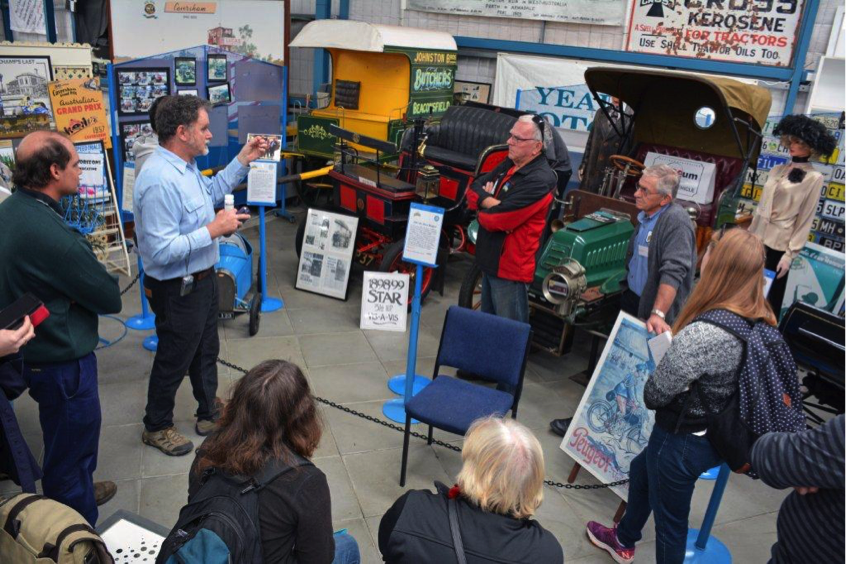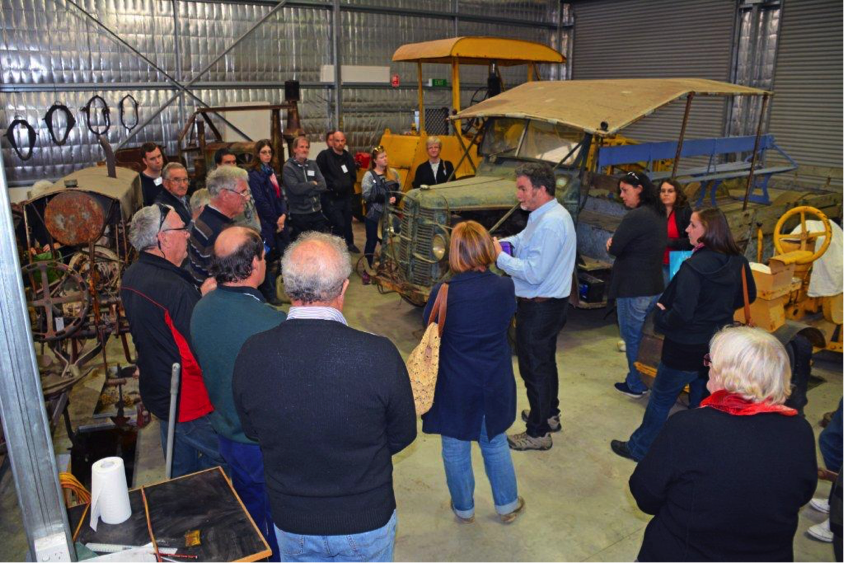Whiteman Park was the ideal venue to host a David Hallam’s Preservation of Functional Objects Workshop. The Park includes several transport collections: Bennett Brook Railway, Revolutions Transport Museum, the Motor Museum of WA, the Tractor Museum of WA, the Perth Electric Tramway Society and the Bus Preservation Society of WA.
The course attracted 30 people, with several coming from the eastern states. There was a mixture of volunteers, many with engineering experience; and people employed in heritage industry—with and without conservation training.
The course was well taught and structured. David has a genuine passion for vehicles of all kinds and a great knowledge of the science and ethics of conservation. While David commented several times about the difficulty in pitching the course to such a diverse audience, he seemed to have the attention of everyone in the group.
The course began with an introduction to planning conservation or restoration work, with risk and significance being the most important factors to consider. While conservators may consider heritage fabric to be the main consideration, David suggests that for functional objects we also need to conserve trades and skills, engineering culture, smell, vibration and memories. Community and social significance should always be considered for functional objects. This is particular relevant to some of the Whiteman Park groups, which have been going since the 1960s.
 One of the liveliest discussions concerned the method of measurement, orientation and nomenclature for reports on individual objects. David suggested using the original measurement system, be it imperial inches or Dutch inches, would make a lot more sense on historic objects. “Dutch inches ??” I googled the term and read out: “one Dutch el is 27 inches”. One participant from Bennett Brook railway thanked me for solving the mystery of why one of the railway tracks had a 27 inch gauge, proving David’s point. Another recommendation was using the original manufacturer’s nomenclature to describe parts. Several participants were stunned to learn that this would mean describing a ‘boot’ as a ‘trunk’ on American vehicles! Conservators love to orient their descriptions with proper left and right, but for vehicles terms such as ‘starboard’ or ‘driver’s side’ are more appropriate.
One of the liveliest discussions concerned the method of measurement, orientation and nomenclature for reports on individual objects. David suggested using the original measurement system, be it imperial inches or Dutch inches, would make a lot more sense on historic objects. “Dutch inches ??” I googled the term and read out: “one Dutch el is 27 inches”. One participant from Bennett Brook railway thanked me for solving the mystery of why one of the railway tracks had a 27 inch gauge, proving David’s point. Another recommendation was using the original manufacturer’s nomenclature to describe parts. Several participants were stunned to learn that this would mean describing a ‘boot’ as a ‘trunk’ on American vehicles! Conservators love to orient their descriptions with proper left and right, but for vehicles terms such as ‘starboard’ or ‘driver’s side’ are more appropriate.
The course included site visits to the bus, tractor and car collections, along with Revolutions Transport Museum. Whiteman Park is a large area, so transport was provided by historic bus on the first day, and historic tram on the second. While heavily restored, the historic vehicles are evocative of the sounds and sights of their era, and the skills required to drive and maintain them. The visits allowed us to discuss various aspects of treatments and storage, and to hear functional machines in action. 
David takes a very pragmatic approach to the conservation of vehicles, employing a lot of commercially available products. We had the benefit of his research into the best engine oils, brake fluids and coolants to use in order to prevent deterioration of the internal components. It was interesting to hear that keeping vehicles functional to some extent is much more economical in the long run. In fact, technology objects must be kept functional in order to lubricate and protect the internal components. Simple things that can keep vehicles in good condition for longer include: placing them on stands, regularly rotating the wheels, and pumping the brakes to distribute fluids and prevent wear to the seals. Special test strips are available to test the coolant system, ensuring it remains protective. Enteroscopes are also useful for examining the condition of internal components, and can now be obtained cheaply at automotive stores.